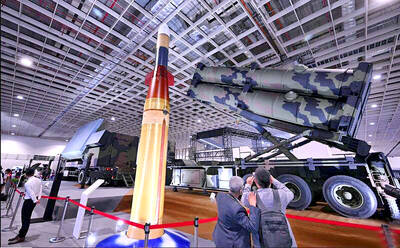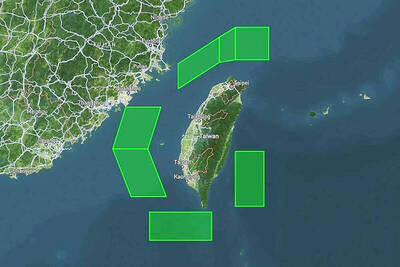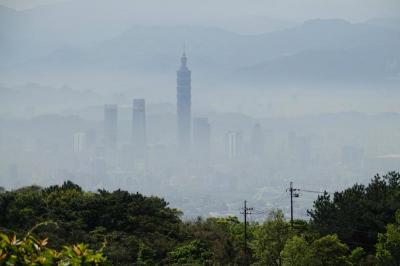Impatient with the Council of Indigenous Peoples’ (CIP) response to Pingpu Aborigines’ demand for recognition, activist Lin Sheng-yi (林勝義), a Pingpu from the Ketagalan tribe, yesterday urged the government to create a separate ministry to handle Pingpu affairs.
“I don’t know why is it so hard for the CIP to officially recognize the Pingpu as Aborigines,” Lin told a news conference in Taipei. “The Pingpu have been considered indigenous peoples by the UN Permanent Forum on Indigenous Issues since 1994 and we’ve always been active in Aboriginal movements — why is it so hard to recognize us as Aborigines?”
“The council is controlled by Aborigines living in the mountains. We demand that the government create a separate agency for the Pingpu,” he said.
Pingpu (平埔) — or “flat lands” — is a term widely used to describe Aborigines who once inhabited most of lowland areas around the country.
The Ketagalan were the first inhabitants of northern Taiwan, with their historical tribal area stretching from Taoyuan County to the Greater Taipei area and parts of Yilan County.
With the arrival of Han immigrants from China, most of the Pingpu were either driven off their own lands or they gradually assimilated into the immigrant communities.
Like other Aborigines, many Pingpu were officially recognized as Aborigines until the 1950s, but they then lost their status because of a failure to register their ethnic status with the government.
In recent decades, many Pingpu have been active in participating in the Aboriginal rights movement, as well as in the campaign to restore official recognition of their ethnic status.
The council has been reluctant to give an immediate, positive response to the Pingpu campaign. However, earlier this year, Council of Indigenous Peoples Minister Sun Ta-chuan (孫大川) resurrected a Pingpu commission within the council — which was first started by the Democratic Progressive Party, but allowed to expire by former council chief Chang Jen-hsiang (章仁香) — to work on resolving the issue.
Lin is equally unhappy with the Pingpu commission.
“What good could a commission with an annual budget of only NT$1 million[US$31,400] do? What could the 12 Pingpu commission members really do within a council that does not recognize the Pingpu?” Lin asked.
Lin’s call for a separate Pingpu affairs agency did not win support from most other Pingpu activists.
“We’re not happy with the council’s slow responses to our demands, but we’re Aborigines, so of course our business is the council’s business,” Kahavu Cultural Association executive director Aylian Hsiao (蕭愛蓮) told the Taipei Times by telephone. “I would not oppose having a separate agency for Pingpu, but it definitely is not my first choice.”
The Kahavu are a Pingpu Aboriginal tribe living in Nantou County’s Puli Towship (埔里).
Head of Tainan County Alliance of Siraya Communities, Tuan Hung-kun (段洪坤), who is also the deputy convener of the council’s Pingpu commission, said he would never have asked for a separate Pingpu agency.
“The Pingpu are Aborigines, we should always stand with our Aboriginal brothers and sisters,” he said. “We’re fighting for our ethnic identity, not for a cultural identity.”

Taiwan is to commence mass production of the Tien Kung (天弓, “Sky Bow”) III, IV and V missiles by the second quarter of this year if the legislature approves the government’s NT$1.25 trillion (US$39.78 billion) special defense budget, an official said yesterday. Commenting on condition of anonymity, a defense official with knowledge of the matter said that the advanced systems are expected to provide crucial capabilities against ballistic and cruise missiles for the proposed “T-Dome,” an advanced, multi-layered air defense network. The Tien Kung III is an air defense missile with a maximum interception altitude of 35km. The Tien Kung IV and V

The disruption of 941 flights in and out of Taiwan due to China’s large-scale military exercises was no accident, but rather the result of a “quasi-blockade” used to simulate creating the air and sea routes needed for an amphibious landing, a military expert said. The disruptions occurred on Tuesday and lasted about 10 hours as China conducted live-fire drills in the Taiwan Strait. The Civil Aviation Administration (CAA) said the exercises affected 857 international flights and 84 domestic flights, affecting more than 100,000 travelers. Su Tzu-yun (蘇紫雲), a research fellow at the government-sponsored Institute for National Defense and Security Research, said the air

A strong continental cold air mass is to bring pollutants to Taiwan from tomorrow, the Ministry of Environment said today, as it issued an “orange” air quality alert for most of the country. All of Taiwan except for Hualien and Taitung counties is to be under an “orange” air quality alert tomorrow, indicating air quality that is unhealthy for sensitive groups. In China, areas from Shandong to Shanghai have been enveloped in haze since Saturday, the ministry said in a news release. Yesterday, hourly concentrations of PM2.5 in these areas ranged from 65 to 160 micrograms per cubic meter (mg/m³), and pollutants were

Taiwan’s armed forces have established response protocols for a wide range of sudden contingencies, including the “Wan Chun Plan” to protect the head of state, the Ministry of Defense (MND) said today. After US President Donald Trump on Saturday launched a series of airstrikes in Venezuela and kidnapped Venezuelan President Nicolas Maduro, concerns have been raised as to whether China would launch a similar “decapitation strike” on Taiwan. The armed forces regularly coordinate with relevant agencies and practice drills to ensure preparedness for a wide range of scenarios, Vice Minister of National Defense Hsu Szu-chien (徐斯儉) told reporters before a